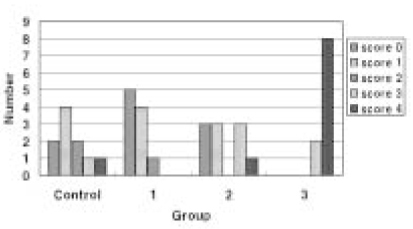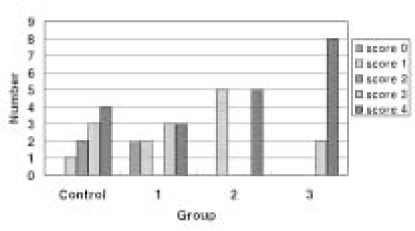Articles
- Page Path
- HOME > Restor Dent Endod > Volume 30(5); 2005 > Article
- Original Article The effect of marginal microleakge according to thickness of flowable resin
- Gi-Gang Song, Young-Gon Cho
-
2005;30(5):-371.
DOI: https://doi.org/10.5395/JKACD.2005.30.5.363
Published online: September 30, 2005
Department of Conservative Dentistry, College of Dentistry, Chosun University, Korea.
- Corresponding author: Young-Gon Cho. Department of Conservative Dentistry, College of Dentistry, Chosun University, 421 Seosuk-dong, Dong-gu, Gwangju, Korea 501-825. Tel: 82-62-220-3840, 3845, Fax: 82-62-232-9064, ygcho@mail.chosun.ac.kr
Copyright © 2005 Korean Academy of Conservative Dentistry
- 86 Views
- 0 Download
Abstract
-
This study investigated the effect of thickness of flowable resin lining on marginal leakage in class II composite restorations. 80 experimental teeth were prepared with class II preparations with enamel margin or dentin margin. Each group was devided into four groups according to flowable resin lining thickness ; Control group - no flowable resin lining, Group 1 - 0.5 mm flowable resin lining, Group 2 - 1 mm flowable resin lining, Group 3 - 2 mm flowable resin lining. The cavities were restored using Scotchbond Multi-Purpose adhesive system, Filtek Flow and Filtek Z 250 composite resin.Following one day storage in distilled water, the restored teeth were thermocycled for 500 cycles and immersed in 2% methylene blue for 24 hours.The results of this study were as follows:1. Ranking of mean microleakage scores at the enamel margins was Group 1 < Control = Group 2 < Group 3. The microleakage of Group 3 was significantly higher than that of Control, Group 1 and Group 2 (p < 0.05).2. Ranking of mean microleakage scores at the dentin margins was Group 1 < Group 2 < Control < Group 3. The microleakage of Group 3 was significantly higher than that of Control, Group 1 (p < 0.05).3. Compared with microleakage between the enamel and dentin margins, enamel margin group were significantly lower than dentin margin group.
HEMA = 2-hydroxyethyl methacrylate, Bis-GMA = bisphenol-glysidyl-methacrylate, TEGDMA = triethylene glycol dimethacrylate, UDMA = urethane dimethacrylate, Bis-EMA = bisphenol-ethylmetacrylate


- 1. Munro GA, Hilton TJ, Hermesch CB. In vitro microleakage of etched and rebonded class 5 composite resin restorations. Oper Dent. 1996;21: 203-208.PubMed
- 2. Malmstrom H, Schlueter M, Roach T, Moss ME. Effect of thickness of flowable resins on marginal leakage in class II composite restorations. Oper Dent. 2002;27: 373-380.PubMed
- 3. Davidson CL, de Gee AJ. Relaxation of polymerization contraction stresses by flow in dental composites. J Dent Res. 1984;63(2):146-148.ArticlePubMedPDF
- 4. Bayne SC, Thompson JY, Swft EJ, Stamatiades P, Wilkerson M. A characterization of first-generation flowable composites. J Am Dent Assoc. 1998;129: 567-577.ArticlePubMed
- 5. Beznos C. Microleakage at the cervical margin of composite class II cavities with different restorative techniques. Oper Dent. 2001;26: 60-69.PubMed
- 6. Estafan AM, Denise E. Microleakage study of flowable composite resin systems. Compend Contin Educ Dent. 2000;21(9):705-708.PubMed
- 7. Lutz F, Krejei I, Schupbach F. Adhesive systems for tooth colored restorations: A review. Schweiz Monatsschr Zahnmed. 1993;103: 537-549.PubMed
- 8. Krejci I, Lutz F, Krejci D. The influence of different base materials on marginal adaptation and wear of conventional class II composite resin restorations. Quintessence Int. 1988;19: 191-198.PubMed
- 9. Payne JH 4th. The marginal seal of class II restorations: Flowable composite resin compared to injectable glass ionomer. J Clin Pediatr Dent. 1999;23(2):123-130.PubMed
- 10. Bayne SC, Jeffrey YT, Edward JS, Perry S, Michelle W. A characterization of first-generation flowable composites. J Am Dent Assoc. 1998;129: 567-577.ArticlePubMed
- 11. Peutzfeldt A, Asmussen E. Composite restorations: influence of flowable and self-curing resin composite lining on microleakage in vitro. Oper Dent. 2002;27: 569-575.PubMed
- 12. Yazici AR, Baseren M, Dayangac B. The effect of flowable composite resin on microleakage in class V cavities. Oper Dent. 2003;28: 42-46.PubMed
- 13. Chuang SF, Jin YT, Lin TS, Chang CH, Godoy FG. Effect of lining materials on microleakage and internal voids of class II resin-based composite restorations. Am J Dent. 2003;16: 84-90.PubMed
- 14. Chuang SF, Liu JK, Chao CC, Liao FP, Chen YHM. Effect of flowable composite lining and operator experience on micoleakage and internal voids in class II composite restorations. J Prosthet Dent. 2001;85: 177-183.PubMed
- 15. Feilzer AJ, de Gee AJ, Davidson CL. Setting stress in composite resin in relation to configuration of the restoration. J Dent Res. 1987;66(11):1636-1639.ArticlePubMedPDF
- 16. Phillips RW, Avery DR. Observation on a composite resin for class II restoration: Two-year report. J Prosthet Dent. 1972;28: 164-169.PubMed
- 17. Gordon M, Plasschaert AJM, Saiku JM, Pelzner RB. Microleakage of posterior composite resin materials and an experimental urethane restorative material, tested in vitro above and below the cementoenamel junction. Quintessence Int. 1986;17(1):11-15.PubMed
- 18. Alonso RC, Mario CS, Lourenco CS, Simonides C. Effect of resin liners on microleakage of class V dental composite restorations. J Appl Oral Sci. 2004;12(1):56-61.ArticlePubMed
- 19. Kwon HC, Kim JU, No BD, Moon JH, Park SJ, Park SH, Park JW, Son HH, Sin DH, Eom JM, Yun TC, Lee GW, Lee SJ, Jeong IY, Jo GM, Jo BH, Jo YG, Choe GG, Heo B, Hwang IN. Conservative dentistry. 2001;Seoul: Sinheung International; 99-104.
- 20. Unterbrink GL, Liebenberg WH. Flowable resin composites as "filled adhesives": Literature review and clinical recommendations. Quintessence Int. 1999;30: 249-257.PubMed
- 21. Civelek M, Erosy M, L'Hotelier E, Soyman M, Say EC. Polymerization shrinkage and microleakage in class II cavities of various resin composites. Oper Dent. 2003;28(5):635-641.PubMed
- 22. Watts and Cash. The method for determining volumetric shrinkage. Meas Sci Technol. 1991;2: 788-794.Article
- 23. Amaral CM, Hara AT. Microleakage of hydrophilic adhesive systems in class V composite restorations. Am J Dent. 2001;14(1):31-33.PubMed
- 24. Gordan VV, Vargas MA, Cobb DS, Denehy GE. Evaluation of acidic primers in microleakage of class 5 composite resin restorations. Oper Dent. 1998;23: 244-249.PubMed
- 25. Chuang SF, Jin YT, Liu JK, Chang CH, Shieh DB. Influence of flowable composite lining thickness on class II composite restorations. Oper Dent. 2004;29: 301-308.PubMed
- 26. Tung FF, Hsieh WW, Estafan D. In vitro microleakage study of a condensable and flowable composite resin. Gen Dent. 2000;48(6):711-715.PubMed
- 27. Peris AR, Duarte S, Andrade MF. Evaluation of marginal microleakage in class II cavities: Effect of microhybrid, flowable, and compactable resins. Quintessence Int. 2003;34: 93-98.PubMed
- 28. Fayyad MA, Shortall AC. Microleakage of dentin-bonded posterior composite restoration. J Dent. 1987;15(2):67-72.PubMed
REFERENCES
Tables & Figures
HEMA = 2-hydroxyethyl methacrylate, Bis-GMA = bisphenol-glysidyl-methacrylate, TEGDMA = triethylene glycol dimethacrylate, UDMA = urethane dimethacrylate, Bis-EMA = bisphenol-ethylmetacrylate


REFERENCES
- 1. Munro GA, Hilton TJ, Hermesch CB. In vitro microleakage of etched and rebonded class 5 composite resin restorations. Oper Dent. 1996;21: 203-208.PubMed
- 2. Malmstrom H, Schlueter M, Roach T, Moss ME. Effect of thickness of flowable resins on marginal leakage in class II composite restorations. Oper Dent. 2002;27: 373-380.PubMed
- 3. Davidson CL, de Gee AJ. Relaxation of polymerization contraction stresses by flow in dental composites. J Dent Res. 1984;63(2):146-148.ArticlePubMedPDF
- 4. Bayne SC, Thompson JY, Swft EJ, Stamatiades P, Wilkerson M. A characterization of first-generation flowable composites. J Am Dent Assoc. 1998;129: 567-577.ArticlePubMed
- 5. Beznos C. Microleakage at the cervical margin of composite class II cavities with different restorative techniques. Oper Dent. 2001;26: 60-69.PubMed
- 6. Estafan AM, Denise E. Microleakage study of flowable composite resin systems. Compend Contin Educ Dent. 2000;21(9):705-708.PubMed
- 7. Lutz F, Krejei I, Schupbach F. Adhesive systems for tooth colored restorations: A review. Schweiz Monatsschr Zahnmed. 1993;103: 537-549.PubMed
- 8. Krejci I, Lutz F, Krejci D. The influence of different base materials on marginal adaptation and wear of conventional class II composite resin restorations. Quintessence Int. 1988;19: 191-198.PubMed
- 9. Payne JH 4th. The marginal seal of class II restorations: Flowable composite resin compared to injectable glass ionomer. J Clin Pediatr Dent. 1999;23(2):123-130.PubMed
- 10. Bayne SC, Jeffrey YT, Edward JS, Perry S, Michelle W. A characterization of first-generation flowable composites. J Am Dent Assoc. 1998;129: 567-577.ArticlePubMed
- 11. Peutzfeldt A, Asmussen E. Composite restorations: influence of flowable and self-curing resin composite lining on microleakage in vitro. Oper Dent. 2002;27: 569-575.PubMed
- 12. Yazici AR, Baseren M, Dayangac B. The effect of flowable composite resin on microleakage in class V cavities. Oper Dent. 2003;28: 42-46.PubMed
- 13. Chuang SF, Jin YT, Lin TS, Chang CH, Godoy FG. Effect of lining materials on microleakage and internal voids of class II resin-based composite restorations. Am J Dent. 2003;16: 84-90.PubMed
- 14. Chuang SF, Liu JK, Chao CC, Liao FP, Chen YHM. Effect of flowable composite lining and operator experience on micoleakage and internal voids in class II composite restorations. J Prosthet Dent. 2001;85: 177-183.PubMed
- 15. Feilzer AJ, de Gee AJ, Davidson CL. Setting stress in composite resin in relation to configuration of the restoration. J Dent Res. 1987;66(11):1636-1639.ArticlePubMedPDF
- 16. Phillips RW, Avery DR. Observation on a composite resin for class II restoration: Two-year report. J Prosthet Dent. 1972;28: 164-169.PubMed
- 17. Gordon M, Plasschaert AJM, Saiku JM, Pelzner RB. Microleakage of posterior composite resin materials and an experimental urethane restorative material, tested in vitro above and below the cementoenamel junction. Quintessence Int. 1986;17(1):11-15.PubMed
- 18. Alonso RC, Mario CS, Lourenco CS, Simonides C. Effect of resin liners on microleakage of class V dental composite restorations. J Appl Oral Sci. 2004;12(1):56-61.ArticlePubMed
- 19. Kwon HC, Kim JU, No BD, Moon JH, Park SJ, Park SH, Park JW, Son HH, Sin DH, Eom JM, Yun TC, Lee GW, Lee SJ, Jeong IY, Jo GM, Jo BH, Jo YG, Choe GG, Heo B, Hwang IN. Conservative dentistry. 2001;Seoul: Sinheung International; 99-104.
- 20. Unterbrink GL, Liebenberg WH. Flowable resin composites as "filled adhesives": Literature review and clinical recommendations. Quintessence Int. 1999;30: 249-257.PubMed
- 21. Civelek M, Erosy M, L'Hotelier E, Soyman M, Say EC. Polymerization shrinkage and microleakage in class II cavities of various resin composites. Oper Dent. 2003;28(5):635-641.PubMed
- 22. Watts and Cash. The method for determining volumetric shrinkage. Meas Sci Technol. 1991;2: 788-794.Article
- 23. Amaral CM, Hara AT. Microleakage of hydrophilic adhesive systems in class V composite restorations. Am J Dent. 2001;14(1):31-33.PubMed
- 24. Gordan VV, Vargas MA, Cobb DS, Denehy GE. Evaluation of acidic primers in microleakage of class 5 composite resin restorations. Oper Dent. 1998;23: 244-249.PubMed
- 25. Chuang SF, Jin YT, Liu JK, Chang CH, Shieh DB. Influence of flowable composite lining thickness on class II composite restorations. Oper Dent. 2004;29: 301-308.PubMed
- 26. Tung FF, Hsieh WW, Estafan D. In vitro microleakage study of a condensable and flowable composite resin. Gen Dent. 2000;48(6):711-715.PubMed
- 27. Peris AR, Duarte S, Andrade MF. Evaluation of marginal microleakage in class II cavities: Effect of microhybrid, flowable, and compactable resins. Quintessence Int. 2003;34: 93-98.PubMed
- 28. Fayyad MA, Shortall AC. Microleakage of dentin-bonded posterior composite restoration. J Dent. 1987;15(2):67-72.PubMed
Citations



Figure 1
Figure 2
Materials used in this study
HEMA = 2-hydroxyethyl methacrylate, Bis-GMA = bisphenol-glysidyl-methacrylate, TEGDMA = triethylene glycol dimethacrylate, UDMA = urethane dimethacrylate, Bis-EMA = bisphenol-ethylmetacrylate
Group classification by thickness of flowable resin
Distribution of microleakage scores and mean rank at enamel margins
Distribution of microleakage scores and mean rank at dentin margins
Statistical analysis of microleakage between each group at enamel margin by Mann-Whitney test
-: no-significant differences (p < 0.05).
*: significant differences (p < 0.05).
Statistical analysis of microleakage between each group at dentin margin by Mann-Whitney test
-: no-significant differences (p < 0.05).
*: significant differences (p < 0.05).
Statistical analysis on the microleakage between enamel and dentin margin in each group by Wilcoxon signed rank sum test
*: significant differences (p < 0.05).
-: no-significant differences (p < 0.05).
HEMA = 2-hydroxyethyl methacrylate, Bis-GMA = bisphenol-glysidyl-methacrylate, TEGDMA = triethylene glycol dimethacrylate, UDMA = urethane dimethacrylate, Bis-EMA = bisphenol-ethylmetacrylate
-: no-significant differences (p < 0.05).
*: significant differences (p < 0.05).
-: no-significant differences (p < 0.05).
*: significant differences (p < 0.05).
*: significant differences (p < 0.05).
-: no-significant differences (p < 0.05).

 KACD
KACD







 ePub Link
ePub Link Cite
Cite

